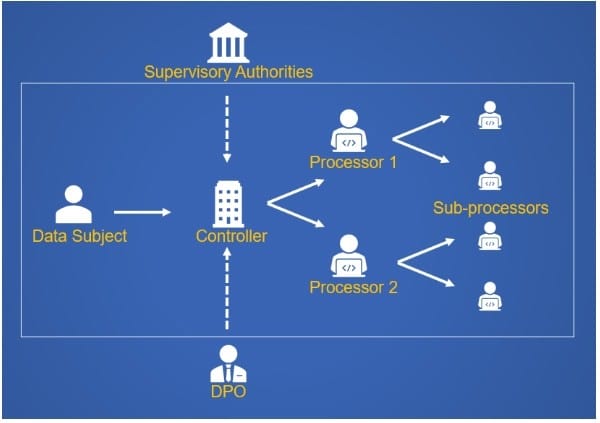Exam Details
Exam Code
:PDPFExam Name
:Privacy and Data Protection FoundationCertification
:EXIN CertificationsVendor
:EXINTotal Questions
:149 Q&AsLast Updated
:Jun 06, 2025
EXIN EXIN Certifications PDPF Questions & Answers
-
Question 31:
Which EU legislation allows data to be transferred between the European Economic Area (EEA) and the United States (USA)?
A. A suitability decision based on the Privacy Shield program
B. A transfer made on the basis of World Trade Organization legislation.
C. European Union Directive 95/46 / EC.
D. A transfer made under UN law.
-
Question 32:
When is a Data Protection Impact Assessment (DPIA) under the General Data Protection Regulation (GDPR) mandatory?
A. Application of new technologies that may imply a high risk to the rights and freedoms of data subjects.
B. There is no security policy and information security risk analysis.
C. In all types of personal data processing.
-
Question 33:
What is the term used in the General Data Protection Regulation (GDPR) for the disclosure of, or unauthorized access to, personal data?
A. Security incident
B. Incident
C. Breach of confidentiality
D. Data breach
-
Question 34:
According to the General Data Protection Regulation (GDPR), which category of personal data is considered to be sensitive data?
A. Labor union association
B. Passport number
C. Credit card details
D. Social security number
-
Question 35:
A person who works for a union took home a draft newsletter to finish it. The thumb drive containing the draft and contact list has been lost. To whom, among others, this data breach should be reported?
A. To all members of the contact list
B. To the Union staff
C. To the police
-
Question 36:
Which of these should appear in a Data Protection Impact Assessment (DPIA) according to the General Data Protection Regulation (GDPR)?
A. An assessment of the need and proportionality of treatment operations in relation to the objectives.
B. Data Protection Officer (DPO) contact and responsibilities.
C. An inventory and the flow of personal data within the organization.
D. A survey of other laws that must be taken into account in addition to the GDPR.
-
Question 37:
To comply with the General Data Protection Regulation (GDPR) it is necessary to create a procedure for reporting data breaches to the Supervisory Authority.
As the controller is a public administration agency, which option is a requirement for this procedure?
A. It must contain a step to perform a Data Protection Impact Analysis (DPIA).
B. It must include an audit step.
C. It should include a step to consult the Data Protection Officer (DPO) in order to determine whether notification to the Supervisory Authority is necessary.
D. It must contain a step to notify the data subject.
-
Question 38:
Who is responsible for demonstrating the compliance of personal data processing with the General Data Protection Regulation (GDPR)?
A. The Data Protection Officer (DPO)
B. The processor
C. The controller
D. The supervisory authority
-
Question 39:
What is the definition of Supervisory Authority according to the GDPR?
A. Individual or legal entity processing personal data on behalf of the person responsible for processing personal data.
B. An independent public authority created by a Member State.
C. Individual or legal entity that is not authorized to process personal data
D. Individual or legal entity that, individually or in conjunction with others, determines the purposes and means of processing personal data.
-
Question 40:
A person buys a product at a store located in the European Economic Area (EEA). At the time of purchase, you are asked to fill out a registration form and he informs his personal email.
As is usual in many stores, in the next few days this person will start receiving several marketing emails. He considers the frequency of these emails to be very high. Demanding his rights, he asks the store to delete all his personal data.
What is the right required by the data subject?
A. Right to erasure
B. Data subject's right of access
C. Right to limitation of treatment
D. Right to rectification
Related Exams:
EX0-001
ITIL Foundation (syllabus 2011)EX0-002
PRINCE2 FoundationExamEX0-003
Managing Successful Programmes FoundationEX0-004
Management of Risk FoundationEX0-005
Management of Portfolio FoundationEX0-006
Management of Value FoundationEX0-007
Portfolio, Programme and Project Offices FoundationEX0-100
ITIL foundation certificate in it service management(exin)EX0-101
Exin ITIL Foundation V 3.0 & ITIL FoundationEX0-102
Microsoft Operations Framework Foundation
Tips on How to Prepare for the Exams
Nowadays, the certification exams become more and more important and required by more and more enterprises when applying for a job. But how to prepare for the exam effectively? How to prepare for the exam in a short time with less efforts? How to get a ideal result and how to find the most reliable resources? Here on Vcedump.com, you will find all the answers. Vcedump.com provide not only EXIN exam questions, answers and explanations but also complete assistance on your exam preparation and certification application. If you are confused on your PDPF exam preparations and EXIN certification application, do not hesitate to visit our Vcedump.com to find your solutions here.
